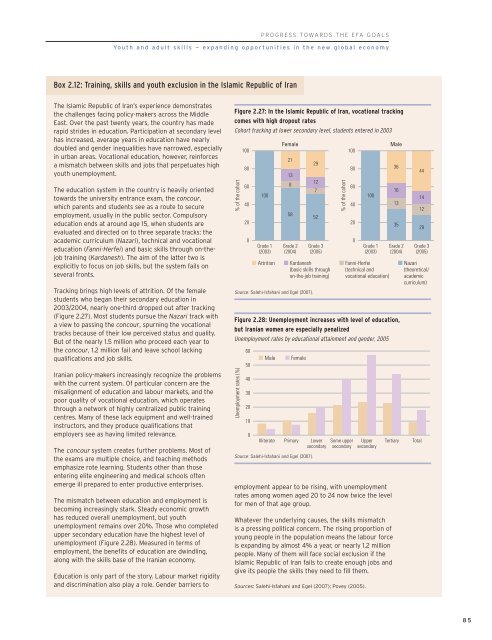Chapter 2. Progress towards the EFA goals - Unesco
Chapter 2. Progress towards the EFA goals - Unesco
Chapter 2. Progress towards the EFA goals - Unesco
Create successful ePaper yourself
Turn your PDF publications into a flip-book with our unique Google optimized e-Paper software.
PROGRESS TOWARDS THE <strong>EFA</strong> GOALS<br />
Youth and adult skills — expanding opportunities in <strong>the</strong> new global economy<br />
Box <strong>2.</strong>12: Training, skills and youth exclusion in <strong>the</strong> Islamic Republic of Iran<br />
The Islamic Republic of Iran’s experience demonstrates<br />
<strong>the</strong> challenges facing policy-makers across <strong>the</strong> Middle<br />
East. Over <strong>the</strong> past twenty years, <strong>the</strong> country has made<br />
rapid strides in education. Participation at secondary level<br />
has increased, average years in education have nearly<br />
doubled and gender inequalities have narrowed, especially<br />
in urban areas. Vocational education, however, reinforces<br />
a mismatch between skills and jobs that perpetuates high<br />
youth unemployment.<br />
The education system in <strong>the</strong> country is heavily oriented<br />
<strong>towards</strong> <strong>the</strong> university entrance exam, <strong>the</strong> concour,<br />
which parents and students see as a route to secure<br />
employment, usually in <strong>the</strong> public sector. Compulsory<br />
education ends at around age 15, when students are<br />
evaluated and directed on to three separate tracks: <strong>the</strong><br />
academic curriculum (Nazari), technical and vocational<br />
education (Fanni-Herfei) and basic skills through on-<strong>the</strong>job<br />
training (Kardanesh). The aim of <strong>the</strong> latter two is<br />
explicitly to focus on job skills, but <strong>the</strong> system fails on<br />
several fronts.<br />
Tracking brings high levels of attrition. Of <strong>the</strong> female<br />
students who began <strong>the</strong>ir secondary education in<br />
2003/2004, nearly one-third dropped out after tracking<br />
(Figure <strong>2.</strong>27). Most students pursue <strong>the</strong> Nazari track with<br />
a view to passing <strong>the</strong> concour, spurning <strong>the</strong> vocational<br />
tracks because of <strong>the</strong>ir low perceived status and quality.<br />
But of <strong>the</strong> nearly 1.5 million who proceed each year to<br />
<strong>the</strong> concour, 1.2 million fail and leave school lacking<br />
qualifications and job skills.<br />
Iranian policy-makers increasingly recognize <strong>the</strong> problems<br />
with <strong>the</strong> current system. Of particular concern are <strong>the</strong><br />
misalignment of education and labour markets, and <strong>the</strong><br />
poor quality of vocational education, which operates<br />
through a network of highly centralized public training<br />
centres. Many of <strong>the</strong>se lack equipment and well-trained<br />
instructors, and <strong>the</strong>y produce qualifications that<br />
employers see as having limited relevance.<br />
The concour system creates fur<strong>the</strong>r problems. Most of<br />
<strong>the</strong> exams are multiple choice, and teaching methods<br />
emphasize rote learning. Students o<strong>the</strong>r than those<br />
entering elite engineering and medical schools often<br />
emerge ill prepared to enter productive enterprises.<br />
The mismatch between education and employment is<br />
becoming increasingly stark. Steady economic growth<br />
has reduced overall unemployment, but youth<br />
unemployment remains over 20%. Those who completed<br />
upper secondary education have <strong>the</strong> highest level of<br />
unemployment (Figure <strong>2.</strong>28). Measured in terms of<br />
employment, <strong>the</strong> benefits of education are dwindling,<br />
along with <strong>the</strong> skills base of <strong>the</strong> Iranian economy.<br />
Education is only part of <strong>the</strong> story. Labour market rigidity<br />
and discrimination also play a role. Gender barriers to<br />
Figure <strong>2.</strong>27: In <strong>the</strong> Islamic Republic of Iran, vocational tracking<br />
comes with high dropout rates<br />
Cohort tracking at lower secondary level, students entered in 2003<br />
% of <strong>the</strong> cohort<br />
100<br />
80<br />
60<br />
40<br />
20<br />
0<br />
100<br />
Grade 1<br />
(2003)<br />
Attrition<br />
Female<br />
21<br />
13<br />
58<br />
Grade 2<br />
(2004)<br />
Grade 3<br />
(2005)<br />
Kardanesh<br />
(basic skills through<br />
on-<strong>the</strong>-job training)<br />
Source: Salehi-Isfahani and Egel (2007).<br />
8<br />
employment appear to be rising, with unemployment<br />
rates among women aged 20 to 24 now twice <strong>the</strong> level<br />
for men of that age group.<br />
Whatever <strong>the</strong> underlying causes, <strong>the</strong> skills mismatch<br />
is a pressing political concern. The rising proportion of<br />
young people in <strong>the</strong> population means <strong>the</strong> labour force<br />
is expanding by almost 4% a year, or nearly 1.2 million<br />
people. Many of <strong>the</strong>m will face social exclusion if <strong>the</strong><br />
Islamic Republic of Iran fails to create enough jobs and<br />
give its people <strong>the</strong> skills <strong>the</strong>y need to fill <strong>the</strong>m.<br />
100<br />
Sources: Salehi-Isfahani and Egel (2007); Povey (2005).<br />
29<br />
12<br />
7<br />
52<br />
80<br />
60<br />
40<br />
20<br />
0<br />
100<br />
Grade 1<br />
(2003)<br />
Fanni-Herfei<br />
(technical and<br />
vocational education)<br />
Male<br />
35<br />
Grade 2<br />
(2004)<br />
Figure <strong>2.</strong>28: Unemployment increases with level of education,<br />
but Iranian women are especially penalized<br />
Unemployment rates by educational attainment and gender, 2005<br />
Unemployment rates (%)<br />
60<br />
50<br />
40<br />
30<br />
20<br />
10<br />
0<br />
Male<br />
Female<br />
Illiterate Primary Lower<br />
secondary<br />
Source: Salehi-Isfahani and Egel (2007).<br />
% of <strong>the</strong> cohort<br />
Some upper<br />
secondary<br />
Upper<br />
secondary<br />
36<br />
16<br />
13<br />
Tertiary<br />
44<br />
14<br />
12<br />
29<br />
Grade 3<br />
(2005)<br />
Nazari<br />
(<strong>the</strong>oretical/<br />
academic<br />
curriculum)<br />
Total<br />
85
















